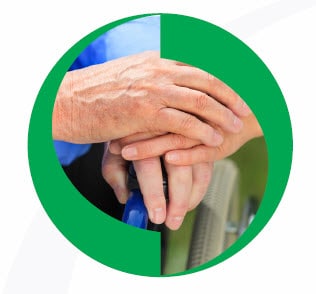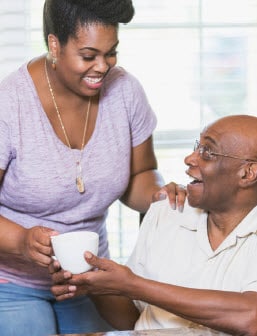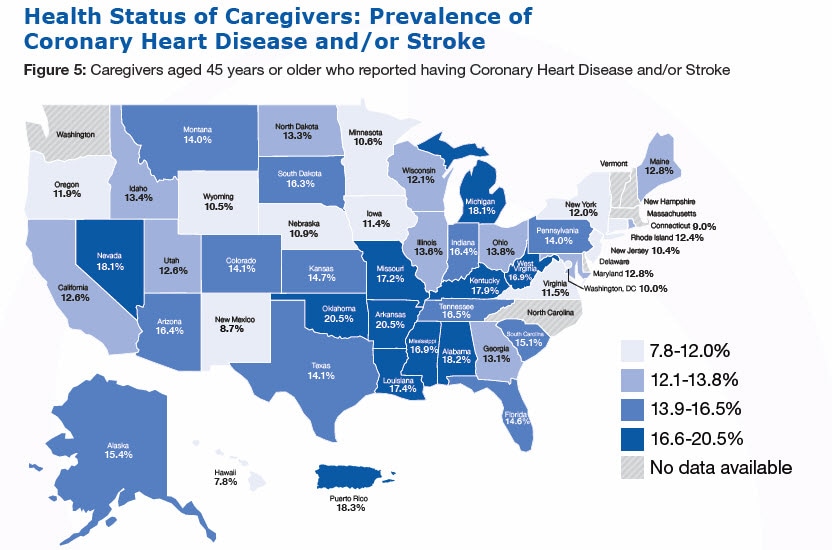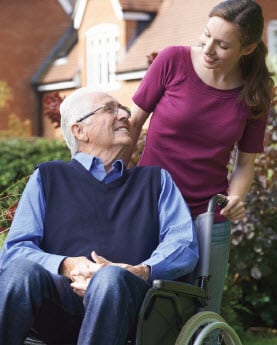Statistics for Percentage of Family That Needs Social and Health Help
Caregiving for Family and Friends — A Public Wellness Issue

Available for Download pdf icon [PDF – i MB]
Caregiving is an of import public health outcome that affects the quality of life for millions of individuals. Caregivers provide assistance with another person's social or health needs. Caregiving may include assistance with one or more activities important for daily living such as bathing and dressing, paying bills, shopping and providing transportation. It also may involve emotional back up and help with managing a chronic disease or disability. Caregiving responsibilities can increase and change every bit the recipient's needs increase, which may result in additional strain on the caregiver.i,2,3
Caregivers can exist unpaid family members or friends or paid caregivers.1,2 Informal or unpaid caregivers are the courage of long-term care provided in people's homes. In item, middle-anile and older adults provide a substantial portion of this intendance in the US, every bit they care for children, parents or spouses.2,3 These informal caregivers are the focus of this brief.2,three
Caregiving can bear on the caregiver's life in a myriad of ways including his/her ability to work, engage in social interactions and relationships, and maintain good concrete and mental health.i Caregiving also can bring great satisfaction and strengthen relationships, thus enhancing the caregivers' quality of life. As the population ages and disability worsens, information technology is disquisitional to understand the concrete and mental health burden on caregivers, the range of tasks caregivers may perform, and the societal and economic impacts of long-term chronic diseases or disability.ii Gathering information on these topics enables u.s. to plan for public wellness approaches to help individuals as well as their communities and maintain the health of caregivers and intendance recipients.1
Breezy caregivers provide regular care or aid to a friend or family unit member who has a health trouble or inability.2,4

Data for Public Wellness Action
With an increasing older developed population and people with disabilities living longer, the need for caregiving is growing. Past acting strategically, public health professionals tin stimulate needed changes to systems that amend the wellness of both caregivers and care recipients, provide preparation to healthcare providers virtually the importance of family caregivers, and ensure that caregivers have the information and support they need to minimize the stress of caregiving.

This cursory examines the following questions:
- What are the characteristics of caregivers and the caregiving situation?
- What percentage of eye–aged and older adults provide care to someone else?
- What percentage of caregivers provide care to a family member or friend with dementia or other cognitive impairment disorders?
- What is the health condition of caregivers?
- What percentage of caregivers have wellness care coverage and get almanac cheque-ups?
- What percentage of caregivers feel unhealthy days and insufficient slumber?
- What percent of caregivers have 2 or more chronic diseases or inability?
- What percentage of caregivers reported having coronary middle disease (including angina and/or myocardial infarction) and/or stroke?
- What percentage of adults not currently caregivers think they volition be caregivers in the futurity?
The caregiving data presented in this brief were collected from customs-habitation adults 45 years of age and older in 2015-2017 through the Behavioral Adventure Factor Surveillance System
(BRFSS).4 Questions related to caregiving were administered as part of the Caregiver Optional Module in 44 states, the District of Columbia and Puerto Rico. For states administering the module during multiple years, the most recent information were used. Additional data reports tin exist generated and viewed through the CDC Alzheimer's Disease and Healthy Crumbling Data Portal.
These data were examined in two age groups, adults 45-64 years and anile 65 years and older, too every bit by sexual activity, race and Hispanic ethnicity, chronic disease status, and other demographic
characteristics.

During the by xxx days did you provide regular care or assistance to a friend or family unit member who has a health problem or inability?

- 22.3% of adults reported providing care or assistance to a friend or family member in the past thirty days.
- 24.4% of adults anile 45 to 64 years are caregivers compared to 18.8% of adults anile 65 years and older.
- One in four (25.4%) women are caregivers compared to ane in five (18.nine%) men.
- 23.1% of Whites are caregivers, compared to 24.3% of Blacks/African Americans, 17.9% of Hispanics, and 10.two% of Asians/Pacific Islanders.
- 24.2% of adults with post-high school instruction are caregivers, compared to 21.8% with high schoolhouse instruction and 15.9% with less than loftier school education.
- I in three caregivers (31.iii%), provided 20 or more hours per week of care and over one-half (53.8%) accept given care or assistance for 24 months or more.
- ten.4% of caregivers reported providing care or assistance to friends or family members with dementia or other cognitive impairment disorder.

Do you accept any kind of health care coverage, including health insurance, prepaid plans such every bit HMOs or government plans such equally Medicare, or Indian Health Service?
Caregivers often neglect their own health needs.iii Having health care coverage and routine check-ups can impact their health status positively.three
- 92.9% of caregivers aged 45 years and older reported that they have some form of health intendance coverage.
- 98.nine% of caregivers aged 65 years and older accept health care coverage in comparison to 90.1% of caregivers aged 45 to 64 years.
- 94.3% of White caregivers reported having health intendance coverage compared to 89.1% of Black/African American caregivers, 85.ii% of Hispanic caregivers, and 94.1% of Asian or Pacific Islander caregivers.
- 79.three% of caregivers aged 45 years and older reported having had a routine checkup in the past year.
- eighty.9% of women caregivers compared to 76.eight% of men reported having a routine checkup.
- 78.two% of White caregivers reported having a routine check-up, compared to 85.0% of Blackness/African American caregivers, 78.6% of Hispanic caregivers and 90.four% of Asian/Pacific Islander caregivers.

Caregiving can be emotionally and physically enervating. Over half (53%) of caregivers indicated that a decline in their health compromises their ability to provide care.3
Now thinking well-nigh your mental health, which includes stress, depression and problems with emotions, for how many days during the past thirty days was your mental health not good?
- 14.5% of caregivers reported experiencing 14 or more mentally unhealthy days in the past month.
Now thinking about your physical wellness, which includes physical disease and injury, for how many days during the past 30 days was your physical health not good?
- 17.6% of caregivers reported experiencing fourteen or more physically unhealthy days in the past calendar month.
On average, how many hours of sleep do you get in a 24 60 minutes period?
Frequent mentally or physically unhealthy days can upshot caregiver's sleep. Insufficient slumber (defined as fewer than vii hours in a 24 hour period) may negatively touch on a caregiver's health and too interfere with their ability to provide intendance.5
- 36.7% of caregivers reported getting insufficient sleep.

Has a doctor, nurse or other health professional always told you lot that you had i of the following: Coronary eye affliction (including angina and/or myocardial infarction), stroke, asthma (still have), cancer (peel, other types of cancer), COPD, arthritis, depressive disorder, kidney disease, diabetes?
Caregivers are at increased risk for having multiple chronic diseases equally they may neglect their ain personal health needs while providing care to others.3
- 40.7% of caregivers study having two or more chronic diseases.
- 53.4% of caregivers anile 65 years and older have two or more chronic diseases compared to 34.8% caregivers aged 45 to 64 years.
Are you limited in whatsoever manner in any activities considering of physical, mental, or emotional issues? OR Do you at present have whatsoever health problem that requires you to use special equipment such as a cane, a wheelchair, a special bed or a special telephone?
Disability status is divers every bit whatever degree of activeness limitations because of physical, mental, or emotional problems or having any health trouble that requires using special equipment such as a cane, a wheelchair, a special bed or a special telephone.
- 33.0% of caregivers reported having a inability.
- 35.5% of caregivers aged 65 years and older reported having a disability compared to 31.9% of adult caregivers aged 45 to 64 years.

Has a doctor, nurse or other wellness intendance professional e'er told y'all had angina or coronary eye disease (Yeah, No), or E'er told you had a middle assault, besides chosen a myocardial infarction? (Yes, No) or Always told you lot had a stroke (Yes, No)?
Persons who have experienced a heart set on or stroke and/or who have electric current coronary heart disease (including angina) may experience limitations acquired past their chronic disease. Because these conditions may crave substantial cocky-care, providing care to someone else may become more challenging.half-dozen
- fourteen.ane% of caregivers reported coronary heart disease and/or stroke.
- 22.two% of caregivers aged 65 years and older reported coronary heart disease and/or stroke compared to 10.3% of caregivers aged 45 to 64 years.
- 17.half dozen% of men caregivers 45 years of age and older reported coronary heart illness and/or stroke compared to eleven.8% of women.
- The prevalence of these conditions varied by racial/ethnic groups: 14.4% of white caregivers, xiii.3% of Blackness/African American caregivers, 12.3% of Hispanic caregivers and 7.6% of Asians/Pacific Islanders caregivers reported coronary centre disease and/or stroke.
**Respondents were classified equally having coronary heart disease (CHD) if they reported having been told by a provider they had CHD. Respondents were also classified equally having CHD if they reported having been told they had a centre attack (i.due east., myocardial infarction) or angina.

In the next 2 years, do you expect to provide intendance or assistance to a friend or family member who has a health problem or disability?

The need for caregivers is expected to continue to grow with increases in the The states older adult population. Currently, in that location are 7 potential family caregivers per older adult. By 2030, it is estimated in that location volition be only iv potential family caregivers per older developed.2
- 17.2% of middle–anile and older adults who are non currently caregivers wait to provide intendance or assistance in the next two years to a friend or family members with a wellness problem or adisability.
- twenty.0% of adults aged 45-64 years who practise not currently provide care to someone expect to do and then in the hereafter compared to 12.eight% of adults aged 65 years and older.
Call to Activity
Caregiving is an increasingly common experience in eye and older adults that cuts across demographic groups. The need for caregivers is expected to abound due to the continued increases in the older developed population. Many heart-aged and older adults who are not currently caregivers do expect to provide intendance in the future. People are caregivers for diverse amounts of time, simply most people provide care for 6 months or more and for many it is equivalent to a part-time task. These caregivers may have a substantial burden of disability and chronic illness as they care for others.
By acting strategically, public wellness professionals can stimulate needed changes to systems that promote the health and well-being of both caregivers and their intendance recipients. Below are some of the actions that you lot and your community can take to make changes that positively impact caregivers.
- Increment messaging that emphasizes both the important office of caregivers and the importance of maintaining caregivers' wellness and well-being.
- Educate the public nearly the importance of caregiving before they begin and the resources and supports available to them.
- Brainwash healthcare providers to exist mindful of the health risks for caregivers, encourage caregivers' use of bachelor data and tools, and make referrals to supportive programs and services.
- Evaluate caregiver training and back up programs to determine program accessibility, effectiveness, and impact.
- Estimate the gap between workforce capacity and anticipated demand for services to support people with dementia and inability and their caregivers.
- Increase awareness of and access to evidence-based programs and services that tin can assist caregivers and care recipients and increase access to these programs and services.
- Encourage caregivers to get regular check-ups, utilize preventive services and engage in self-care to maintain health.
- Ensure that caregivers with a disability and/or chronic diseases accept admission to self-direction programs to maintain their health.
For additional actions refer to The Healthy Brain Initiative: Land and Local Public Health Partnerships to Address Dementias, The 2018-2023 Road Map vii
Technical Data
The Behavioral Risk Factor Surveillance Arrangement (BRFSS) is the nation's premier organisation of health- related phone surveys that collect state data about U.S. residents regarding their health-related adventure behaviors, chronic health weather condition, and use of preventive services. Established in 1984 with 15 states, BRFSS now collects data in all l states equally well as the District of Columbia and three U.S. territories.
BRFSS completes more than 450,000 adult interviews each year, making it the largest and longest continuously conducted wellness survey system in the world.
CDC'south Behavioral Risk Factor Surveillance Organisation (BRFSS) helps states survey U.S. adults regarding a broad range of wellness issues and behaviors that affect their health. The crucial information gathered through this state-based telephone surveillance organisation is used by national, state, and local public health agencies to place populations that might be most at risk and to monitor the need for and the effectiveness of various public wellness interventions.
Although the BRFSS is a useful tool for assessing caregiving in middle-aged and older adult populations, information technology has some limitations: it excludes people who practice not have telephones or are in institutions such as nursing homes; it may underrepresent people who are severely impaired considering of the functional capacity required to participate in the survey; and responses to BRFSS are self-reported and therefore accept non been confirmed by a healthcare provider. Despite these limitations, the BRFSS is a uniquely powerful tool to provide the prevalence of caregiving and related issues among older community-dwelling house U.S. adults, due to its large sample size and proven reliability and validity.
The BRFSS is administered and supported by the Sectionalisation of Population Health, National Center for Chronic Disease Prevention and Health Promotion, CDC. For more information, delight visit https://www.cdc.gov/brfss.
Footnotes
- Talley R., Crews J., Caring for the Most Vulnerable: Framing the Public Health of Caregiving. Am J Public Health. 2007;97:224–228.
- Hoffman D, Zucker H. A Call to Preventive Activity by Wellness Care Providers and Policy Makers to Back up Caregivers. Prev Chronic Dis 2016;xiii:160233
- https://www.cdc.gov/aging/caregiving/alphabetize.htm, accessed August 2018
- Behavioral Risk Cistron Surveillance System, Centers of Disease Control and Prevention 2015 – 2017.
- Seeking That Elusive Good Night Sleep, https://www.caregiver.org/external iconseeking-elusive-good-dark-slumber, accessed Baronial 2018
- Prevo L, KlaasJan H, et.al. Population Characteristics and Needs of Breezy Caregivers Associated With the Risk of Perceiving a High Burden: A Cross- Exclusive Study. The Periodical of Wellness Care Organization, Provision, and Financ- ing Volume 55: ane–thirteen. 2018
- https://www.cdc.gov/aging/healthybrain/roadmap.htm accessed August 2018.
Disclaimer: The mark "CDC" is owned by the U.S. Section of Health and Human Services (HHS) and is used with permission. Use of this logo is not an endorsement by HHS or the Centers for Illness Control and Prevention (CDC) or whatsoever particular product, service, or enterprise.
blakeneyablion1975.blogspot.com
Source: https://www.cdc.gov/aging/caregiving/caregiver-brief.html
0 Response to "Statistics for Percentage of Family That Needs Social and Health Help"
Post a Comment